Apr 13, 2016 © Ulrich Theobald
The monetary system of the Qing dynasty 清 (1644-1911) was a bimetallic one, consisting of two types of money used in two separate markets, namely silver ingots (yinliang 銀兩, yinding 銀錠) for the wholesale market and larger transactions (as well as for accounting) and copper cash (tongqian 銅錢, actually brass) for the retail market and small transactions.
The denomination of copper cash was one wen 文 (one "cash") - larger denominations being exceptions, that of the silver ingots was basically one liang 兩 (by Westerners known as one tael, from a Malay word), but there were also fractions of this value, as well as multiple ones.
The exchange rate between silver tael and copper cash was theoretically 1 : 1,000, but in daily life this rate fluctuated over time and in different places. One might say that until c. 1800 the exchange rate was in practice 1 : 7-800, but increased, for several reasons, dramatically in the early nineteenth century to about 1 : 1,200. The exchange rate was influenced by the amount of silver and copper cash on the monetary markets, but also by the quality of the copper cash. Fresh coins directly coming from the mint were appreciated higher than worn-out old coins. The normal way to bring fresh coins on the market was through the military pay (junxiang 軍餉).
Copper cash was cast by using models (fanzhu 笵鑄 - and not minted - in state-operated mints, of which there were two in Beijing, and one in almost each provincial capital. This cash was called "standard cash" (zhiqian 制錢) and was characterized by defined standards as to weight and diameter.
The primitive production process made forgery an easy business, and there were many illegal coins (siqian 私錢, sizhuqian 私鑄錢) circulating in China. They were, nevertheless, accepted by the markets because the qualitative difference between legal and illegal coins was often not that great, and because the markets demanded more money than the government was able to produce. The economy in late imperial China was a highly monetized one.
In the second half of the nineteenth century, the central government began experimenting with new types of currencies, including paper money and coins of denominations larger than one cash ("large money" daqian 大錢), and around 1880 began producing of machine-struck coins in the Western style (brass coins and silver coins). Older silver coins, particularly Spanish and Mexican foreign silver dollars, had for a centuries been used in the markets of the coastal provinces of China.
Tibet and Xinjiang, even if occupied by the Qing empire, circulated different currencies, namely Tibetan Silver Coins and Turkestan Pul Coins.
Copper Cash
Figure 1ab. Coins from the Tianming reign-period (Nurhaci)
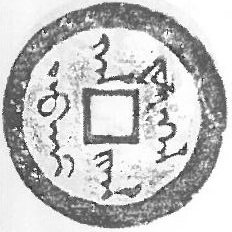 | 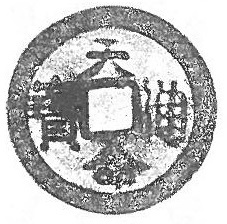 |
Coins from the Tianming reign-period under the Jurchen khan Nurhaci. Left with Manchurian, right with Chinese legend. ⌀ 28.5/26.51mm; 6.1/5.1g. Click to enlarge (opens in new tab). All coin rubbings from Ma Feihai 馬飛海, Wang Yuxuan 王裕巽, Zou Zhiliang 鄒誌諒, ed. (2004). Zhongguo lidai huobi daxi 中國歷代貨幣大系, Vol. 6, Qingdai bi 清代幣 (Shanghai: Shanghai shiji chuban jituan/Shanghai jiaoyu chubanshe), here: no. 4, 33. |
The Manchus began producing Chinese-style coins just after Nurhaci's proclamation to khan in 1616. Coins with a Chinese legend (Tianming tongbao 天命通寶) were supplemented by such with a Manchu inscription (ᠠᠪᡴᠠᡳᡶᠣᠯᡳᠩᡴᠠᡴᠠᠨᠵᡳᡴᠠ Abkai fulingga han jiha "money of the Khan [who was bestowed] the Heavenly mandate", in ancient script without diacritical marks). The Chinese-language coins were smaller than the Manchu ones, but worth ten cash (dang shi 當十). In 1627 Manchu-language coins (with the inscription ᠰᠣᡵᠠᡴᠠᠨᡳᠵᡳᡴᠠ Sure han ni jiha "money of the wise Khan") of ten cash of value were produced. Both carried the inscription yi liang 一兩, meaning that they had the nominal weight of one liang (or ten qian 錢, see weights and measures), and were thus an imitation of the contemporary cash coins of the Ming dynasty 明 (1368-1644).
Figure 2. Coin from the Tiancong reign-period (Huwang Taiji)
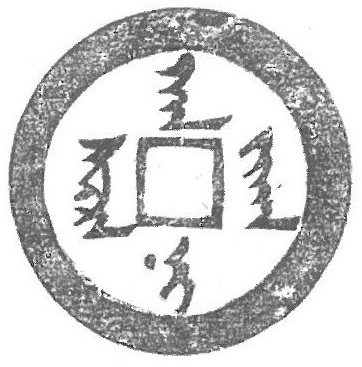 |
Coin from the Tiancong reign-period, with Manchurian legend. ⌀ 43.4mm; 26.2g. Inscription on the reverse side: juwan, emu yan "ten, one tael". Ma 2004: 52. |
In 1644, when the Manchus began conquering China, they adopted the coin system of the Ming and established two mints in Beijing, namely the baoyuanju 寶源局 of the Ministry of Works (gongbu 工部, with the inscription ᠶᡠᠸᠠᠨᠪᠣᡠ yuwan boo) and the baoquanju 寶泉局 of the Ministry of Revenue (hubu 戶部, with the inscription ᠴᡳᡠᠸᠠᠨᠪᠣᡠ ciowan boo). The weight of one cash coin, with the nomination of one cash/qian/wen (in Manchurian ᠵᡳᡥᠠ jiha), was accordingly 1 qian (c. 3.7g), but in 1645 the standard weight was altered to 1.2 qian, in 1651 to 1.25 qian, and in 1657 to 1.4 qian. The alloy was fixed at 7 parts of copper (hongtong 紅銅) to 3 parts of zinc (baiqian 白鉛). The two capital mints were the only places where coins were produced in the early years of the Qing period. The official exchange rate in 1644 was inherited from the mid-Ming period and stood at 7 cash per 0.01 liang (1 fen 分) of silver, while old Ming-period coins were traded at a rate of 14 cash per fen of silver. A year later it was fixed at 10 cash per fen of silver.
Coins of the Shunzhi reign-period had five different shapes. The first followed the traditional shape, with no inscription or symbol on the back side (called guangbei qian 光背錢), or just a dot or a symbol indicating the mint. The second type was inscribed on the back with a single Chinese character (dan hanzi ji ju qian 單漢字記局錢), indicating the mint, namely hu 戶 for the Baoquanju and gong 工 for the Baoyuanju (written either above the central hole, or right to it), and an according abbreviation for the provincial mints (see table below). This type had rarely been used before (for instance, in the coin types Kaiyuan tongbao 開元通寶 and Huichang tongbao 會昌通寶 and from the Tang period 唐, 618-907, and Dazhong tongbao 大中通寶 and Hongwu tongbao 洪武通寶 from the [pre-]Ming period). These two types of coins were used in the early years of the Shunzhi reign-period.
From 1653 on new types emerged, namely the so-called "one-cash coin" (yiliqian 一厘錢), indicating that the value of the coin corresponded to 0.001 liang (1 li 釐 or 厘 "cash", as a weight) of silver (zhe yin yi li qian 折銀一厘錢). Numismatists therefore call this type of coin zheyinqian 折銀錢 "conversion coins". The word yi li was written on the back, to the left side of the central hole, while the short designation of the mint was inscribed to the right. Similar coins were used by some of the Southern Ming 南明 (1644-1661) princes. The use of them is a proof for the continuing importance of silver as a currency of account. The fourth type of coin carried two Manchurian words on the back, namely the short name of the mint (either ciowan or yuwan), and the word boo (i.e. Chinese bao 寶; Manwen ji ju qian 滿文記局錢). This type was not produced in provincial mints. In the fifth type of Shunzhi coins, the name of the mint was given two times, once in Chinese characters to the right, and once in Manchurian script to the left of the central hole (Man-Hanwen ji ju qian 滿漢文記局錢).
Figure 3a-f. Coins from the Shunzhi reign-period
Five types of reverse patterns of coins from the Shunzhi reign-period. Ma 2004: 101, 114, 219, 283, 311. Click to enlarge and for detailed information (opens in new tab). |
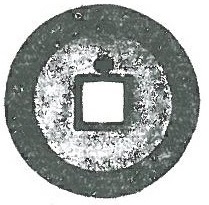 |
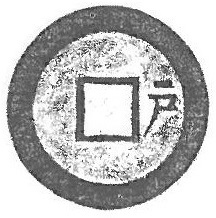 |
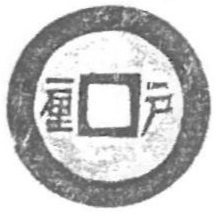 |
No inscription, but a dot signifying the mint. ⌀ 23.7mm; 2.9g. |
Name of mint (戶 for Baoyuanju, Min. of Rev.) in Chinese. ⌀ 25.4mm; 5g. |
Mint 戶 and nominal value 一厘. ⌀ 25.7mm; 4.3g. |
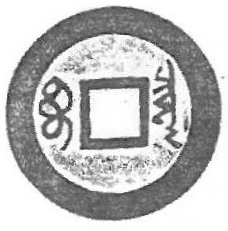 |
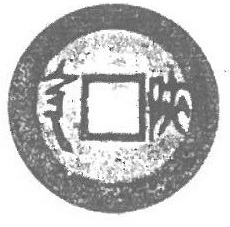 |
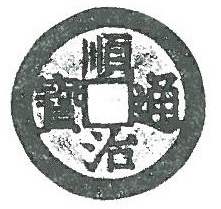 |
Name of mint in Manchurian (ciowan boo). ⌀ 26.8mm; 4.5g. |
Name of mint in Chinese and Manchurian (陝 šan). ⌀ 26.5mm; 4.6g. |
Obverse side of first coin, reading (cross-wise) Shunzhi tongbao 順治通寳. |
In 1684 a new series of measures in the field of monetary policy was initiated. The standard weight was lowered to exactly 1 qian, and the alloy was adjusted at a copper–zinc rate of 6 : 4. In 1702 the weight was again raised to 1.4 qian, and a small or light coin (xiaoqian 小錢 or qingqian 輕錢) created with a weight of 0.7 qian, circulating along with the normal "heavy" or full-weight coins (zhongqian 重錢). The purchase value of these two coins stood at 0.7 liang of silver for 1,000 light cash (or 14.3 light cash per fen of silver), and 1 liang of silver for 1,000 heavy cash (or 10 heavy heash per fen of silver). The light coins disappeared from circulation in the mid-18th century.
Figure 4ab. Coins of the Kangxi reign-period
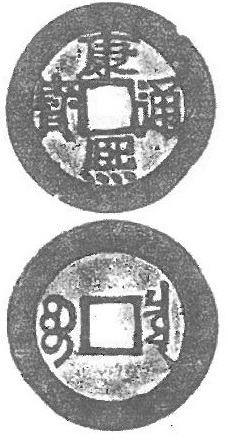 |
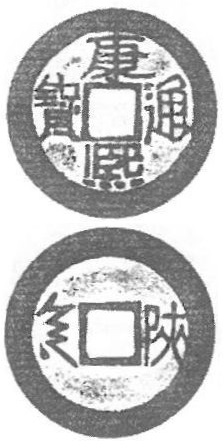 |
Coin from the Kangxi reign-period, capital mint. ⌀ 26.7mm; 4.1g. Ma 2004: 385. |
Coin from the Kanxi reign-period, provincial mint (Shaanxi). ⌀ 26.5mm; 4.7g. Ma 2004: 484. |
The outer rim on both sides was quite wide, in contrast to that of the square hole (chuan 穿) in the middle of the coin. Apart from the two capital mints, there were mints in most provinces of the empire, in some even two. Not all of them did operate through the whole Qing period. Some of them, like the Anhui mint, only produced coins for several years. During the Kangxi reign-period, the inscriptions of the coins of the two capital mints was in Manchurian (ciowan boo, yuwan boo), while those of the provincial mints was held in a mixed Chinese-Manchu style, the short name in a Chinese character to the right, with the Manchu transliteration to the left (like 浙 [zhe, for Zhejiang] to the right, and ᠵᡝ je to the left). From the Yongzheng reign-period 雍正 (1723-1735) on the characters on the back side were replaced by a purely Manchurian inscrition, the names of the mints thus written in Manchu letters (like ᠵᡝᠪᠣᡠ je boo for zhe bao 浙寶).
Figure 5. Coin from Yarkant
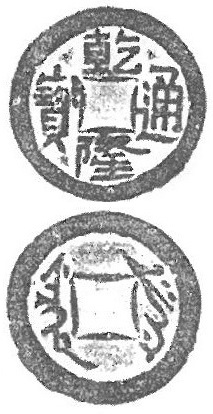 |
Pul coin from Yarkant from the Qianlong reign-period. While the standard inscription Qianlong tongbao 乾隆通寳 is shown on the obverse side, the reverse one has inscriptions in two langues, namely Turki (right) and Manchu (left), both saying "Yarkant". ⌀ 24.6mm; 7.6g. Ma 2004: 1235. |
During the Qianlong reign-period 乾隆 (1736-1796) the Zhili mint in Baoding 保定 was founded, as well as several mints in Eastern Turkestan, mainly in Yili 伊犁, Yerkant يارﻛﻨﺪ, Aksu اﻗﺴﻮ and Uši اﺷﻲ, probably also in Khotan خوتن, Kashgar قاشقر, and Qarashahr. These did not produce Chinese standard cash, but a coin adapted to the local pul ﭘول coins with a high copper content, and therefore called red cash (hongqian 紅錢). They had a mixed Manchu-Turki inscription on the back side (place name in Turki to the right, and boo in Manchurian to the left) and were worth 5 standard cash.
Figure 6a-c. Coins from the Qianlong reign-period
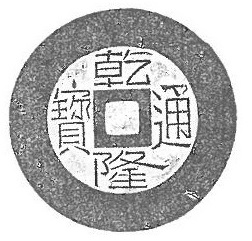 |
 |
 |
Coin from the Qianlong reign-period, coin model (diaomu 雕母). ⌀ 28.5mm; 9.3 g. Ma 2004: 944. |
Coin from the Qianlong reign-period, "mother cash" (muqian 錢母). ⌀ 27.9mm; 7.8g. Ma 2004: 964. |
Coin from the Qianlong reign-period, circulating coin.
⌀ 27.5mm; 6g. Ma 2004: 976. |
Early Qing period cash had no tin and was called yellow cash (huangqian 黃錢). From 1740 on two per cent of tin (xi 錫) were added to a type of alloy used for so-called "green cash" (qingqian 青錢). In fact there was not difference in the appearance of the two alloys. From 1741 on each casting round (mao 卯) of the Baoquanju Mint yielded 12,490 strings of cash (with 1,000 cash per string). These coins consisted of 50 per cent of copper, 41.5 per cent of zinc (baiqian), 6.5 per cent of lead (heiqian 黑鉛), and 2 per cent of tin.
The reason for this change of the alloy was the wish to reduce the tendency to melt down coins to produce brass objects. The new allow did not allow to reuse the material because it would become brittle and objects would easily break. It can be seen that the material value of the coins was at that time higher than its nominal value (the coins were undervalued), so people preferred using of the metal instead of the money. In fact, the production cost was about 15 per cent of the material value. Yet in practice not all mints followed the directive to change the alloy and continued to produce the cheaper copper-zinc alloy.
In 1799, the alloy was again changed to 53 per cent of copper, 41.5 per cent of zinc, and 6.5 per cent of lead. The Taiping rebellion changed the situation of the mint metal supply critically. The supply of zinc had been a problem since the beginning of the century, but the Taiping occupied the route from Yunnan to eastern and northern China, and so cut off the rich copper-ore mines in the soutwest from eastern and northern China. It was therefore decided to produce coins with larger denominations which allowed to save copper.
For this purpose, the government urged people to sell their copper utensils to the mint. The Xianfeng Emperor 咸豐 (r. 1850-1861) re-opened the mints in Kaifeng 開封, Jizhou 薊州, Jinan 濟南, Taiwan 臺灣 and Gongchang 鞏昌, and founded a new one in Chengde 承德.
Figure 7a-i. Coins from the Xianfeng reign-period
Large cash from the Xianfeng reign-period, all from the Baoquanju Mint. |
 |
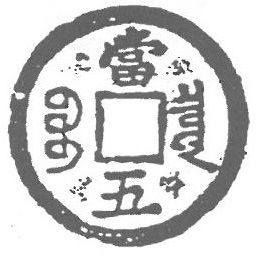 |
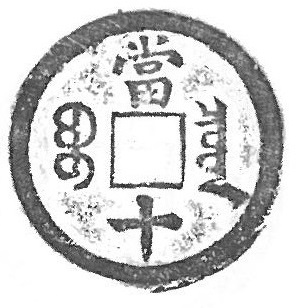 |
"Small" 1-cash coin. ⌀ 27.43mm; 8g. Ma 2004: 1936. |
5 cash. ⌀ 30mm; ?g. Ma 2004: 1981. |
10 cash. ⌀ 34.11mm; 15g. Ma 2004: 2023. |
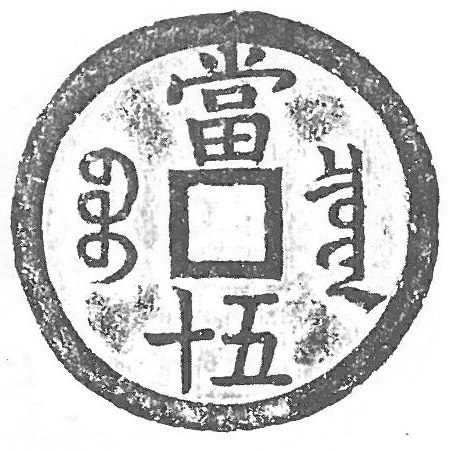 |
 |
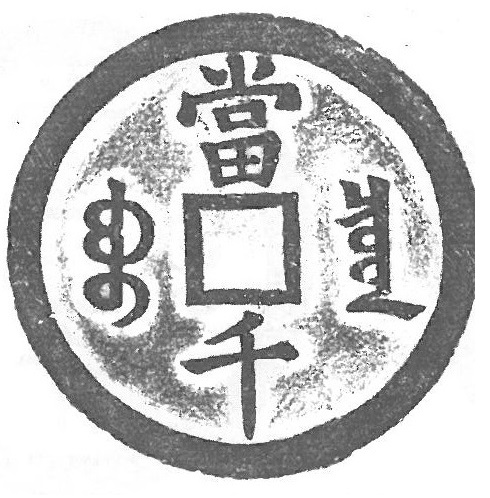 |
50 cash. ⌀ 54mm; 65.6 g. Ma 2004: 2102. |
100 cash. ⌀ 53mm; 48.5g. Ma 2004: 2151. |
1,000 cash. ⌀ ?mm; ?g. Ma 2004: 2222. |
 |
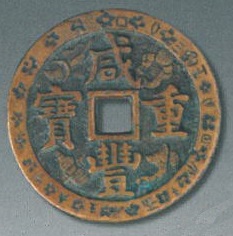 |
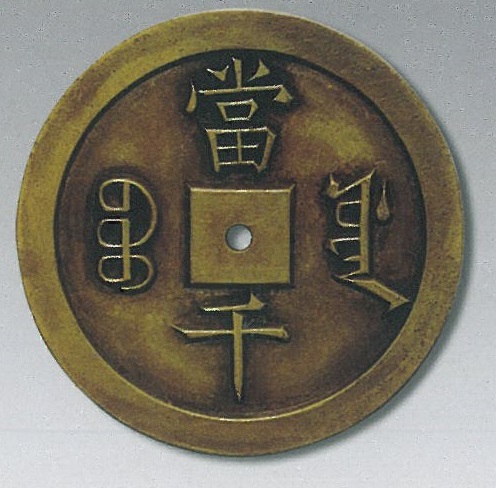 |
500 cash, with decorated background and rim. ⌀ 57mm; ?g. Dai 2008: 140. |
50 cash, with decorated rim. ⌀ 47mm; ?g. Dai 2008: 144. |
1,000 cash. ⌀ ?mm; ?g. Dai 2008: 139. |
The denominations of large cash (daqian) ranged from 4 to 1,000 wen. The 4-wen coin (with the inscription dang si 當四) was only produced in Ili, the 5-wen coin in many places, 8-wen only in Dihua 迪化, Xinjiang, 10-wen everywhere, 20-wen just in Fujian, Zhejiang and Jiangsu, 30-wen just in Zhejiang and Jiangsu, 40-wen only in Zhejiang, 50-wen coins mainly in Shanxi and Dihua, 80-wen coins in Dihua, 100-wen coins mainly in Shanxi, Dihua, Guizhou and Jiangxi, and coins of the denominations 200, 300, and 400 just by the Baoquanju Mint in Beijing, and such with the denominations of 500 and 1,000 wen in many places.
Apart from copper iron and zinc was used for the coins of the denominations 10, 50, 100, 500 and 1,000. The traditional 1-wen coins of the Xianfeng era were still called Xianfeng tongbao 咸豐通寶, the others Xianfeng zhongbao 咸豐重寶, and coins with the denominations 100 and higher were given the name Xianfeng yuanbao 咸豐元寶. Yet there were local exceptions from this rule. Perhaps the largest of the Xianfeng coins were the so-called zhenku daqian 鎮庫大錢. Yet they were not valid as currency and had therefore no denomination.
Figure 7. Xianfeng yuanbao 咸豐元寶 coin
 |
Xianfeng yuanbao 咸豐元寶 coin, called zhenku money 鎮庫錢 and produced by the Quanbao Mint in Beijing. ⌀ 117.43mm; 902.1g. Ma 2004: 2232. |
The system of Xianfeng coins was quite puzzling and therefore not readily accepted by the markets. 50-wen coins, for instance, were larger than 100-wen coins. The coins produced in the various provincial mints were also not uniform. The mint of Fujian, for instance, added to the denomination an information about the weight of the coin. Some inscriptions were in Chinese, others in Manchurian, and on some Xinjiang coins, both languages were used, and in addition to that also Turki. The alloy used for the various Xianfeng coins were not standard. There were iron coins, zinc (qian) coins, copper coins, and among the latter varying alloys with tin and zinc, so that there were "red copper coins" (hongtong), "purple" ones (zitong 紫銅) or yellow ones (huangtong 黃銅). 1-wen coins (zhiqian 制錢) were cast of copper, iron and zinc, 4-wen coins of red copper, 5-wen coins of copper and iron, 8-wen coins of red copper, 10-wen coins of copper, iron, and zinc, 20-, 30- and 40-wen coins of copper, 50-wen and 100-wen coins of copper, iron, and zinc, 200-, 300- and 400-wen coins of copper, and 500- and 1,000-wen coins of copper, iron, and zinc.
To add to the confusion, the official designations of coins of various denominations changed, the smallest being called tongbao, 4- to 50-wen coins zhongbao, and those above 50 wen were called yuanbao; yet even from this rule, there were some exceptions. Numismatists have to battle with a raising number of mints. Already closed ones were opened again (see table), and new ones created, like the Chengde 承德 mint (baodeju 寶德局), the Dihua mint (baodiju 寶迪局) or that in Kuča (baokuju 寶庫局).
The coins issued by the Heavenly Kingdom of the Taiping are quite diverse. It seems that the central government had allowed local power-holders to produce their own coins in their jurisdiction. Yet three types of coins are quite prominently. In the capital Tianjing 天京 (Nanjing) coins with the denominations 1 (known as xiaoping 小平), 5, 10, 50 and 100 were produced, inscribed in regular kaishu script 楷書 with the words Taiping tianguo 太平天囯 on the obverse, and shengbao 聖寶 on the reverse side. The coins have a wide rim and are polished in an excellent way and imitate the coins in the style of the Suzhou mint from the Xianfeng period.
The second type used Song period-style script (songti 宋體 or fangti songzi 方體宋子). These coins are somewhat heavier than the first set, the copper content lower, and the polishing somewhat less accurate. These coins were produced in the region of Hengyang 衡陽, Hunan, and had the denominations 1, 10, 50 and 100.
The characters on the third type, written in kaishu and also circulating in Hunan, were not protruding from the surface as high as that of the other types of coins. There were four denominations, and the second difference to the other types was that the words shengbao were written to the right and left of the central hole.
Apart from the many local coins deviating from these patterns, the main problem of Taiping coins is that the denomination was not written on the coins, but can only be determined by the weight (for the first type, 3g, 5g, 8g, 12g and 31g). This circumstance does not only pose a problem for numismatists, but certainly had also concrete disadvantages in daily use. It might be that in practice one of the coins was traded at 2 wen of value, even if such coins had only existed officially during the Song period, and experiments with 2-wen coins had been made during the late Ming.
After the death of the Xianfeng Emperor, a small number of coins were issued with the reign motto Qixiang 祺祥 (Sep-Nov 1861). The Tongzhi Emperor 同治 (r. 1861-1874) did not issue a large numbers of coins, neither traditional ones nor such with larger denominations. The markets had not readily accepted the latter and behaved quite conservatively in face of the monetary experiments.
Yet the 10-wen coin continued as part of the monetary system under the Guangxu reign-period 光緒 (1875-1908). The alloy was 60 per cent of copper to 40 per cent of zinc, and its weight was fixed at 2.6 qian in 1883. The first standard coins of 1 wen with the inscription Guangxu tongbao 光緒通寶 were only produced from 1887 on. The government had decided to increase the number of the traditional small cash coins on the markets and had a large number of them cast by all mints throughout the empire. Some new mints were opened, namely two in Tianjin, one in Jilin 吉林, one in Fengtian 奉天 (Shenyang), and the modern Nanjing Mint (Nanjing zhibi chang 江南製幣廠). During these years the mechanical production of coins began, and modern paper money was first issued. The two mints in Beijing were rarely operating under the Guangxu Emperor and were closed during the Xuantong reign-period 宣統 (1909-1912). The traditional coins were more and more replaced by modern machine-struck coins with the inscription Da-Qing tongbi 大清銅幣 and a weight of 3g.
Figure 9a-f. Coins of the Guangxu reign-period
Machine-struck coins from the late 19th century, top row in the ancient style, and bottom row in modern Western outlook. |
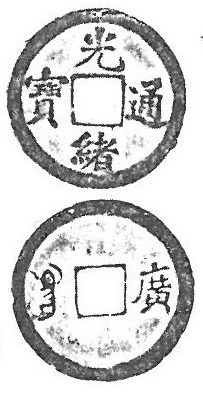 |
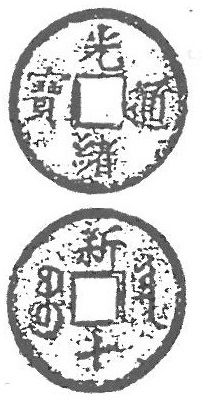 |
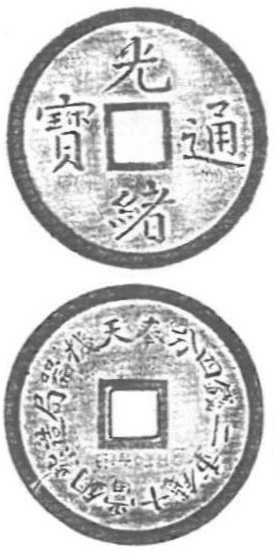 |
Coin from Guangdong. ⌀ 22.63mm; 2.2g. Ma 2004: 4549. |
Coin from Dihua, Xinjiang. ⌀ 22.9mm; 3.25g. Ma 2004: 4604. |
Coin from Fengtian (Shenyang). ⌀ 33.08mm; 9.61g. Ma 2004: 4606. |
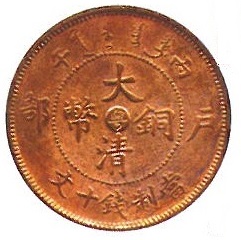 |
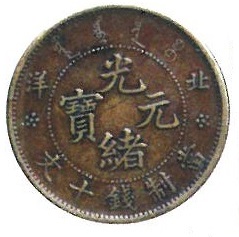 |
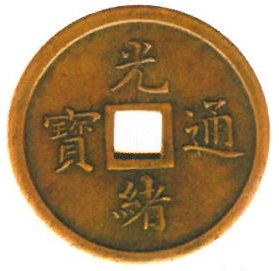 |
Da-Qing tongbi 大清銅幣 "Tai Ching Ti Kuo Copper Coin" from Beijing, ten cash (dang zhiqian shi wen 當制錢十文). ⌀ 29.5mm; 7.35g. Duan 2006: 125. |
Guangxu yuanbao 光緒元寶 "Pei Yang Ten Cash" produced by the modern Beiyang Mint 北洋機器局. ⌀ 27.9mm; 7.3g. Duan 2006: 1079. |
Mechanically produced 10-cash coin from Fengtian, with central hole, inscr. 奉天機器局造紫銅當十錢重二錢四分 (weight 0.24 liang). ⌀ 33.2mm; 8.6g. Duan 2006: 3891. |
The first suggestion to use mechanical production was made by Zhong Dakun 鍾大焜 from Fujian in 1867. In Jilin in 1882 the copper prototypes were used based on Western silver coins, but the Ministry of Revenue resisted the Empress Dowager Cixi's 慈禧太后 proposal to buy foreign machines, so finally she ordered the reform-minded statesman Li Hongzhang 李鴻章 to make tests in the Tianjin mint that had been founded by him. In 1885 the governor-general of Min-Zhe, Yang Changjun 楊昌濬, had machine-struck coins produced with a weight of 8.5g, of which sadly none have survived. Only the small 3g-coins from the Fujian mint are found among collections, yet these might be of a later date.
Tests were also carried out by the Zhili mint and the modern Nanjing mint. The first successful implementation of modern coin production was in Guangdong, carried out under the supervision of Zhang Zhidong 張之洞 in 1889. These modern copper coins had a fix exchange rate to silver ingots, namely the traditional rate of 1 : 1,000. The coins had the inscription Kuping yi qian 庫平一錢 "One cash of the state treasury" (see kuping tael 庫平), which was soon changed to guwang boo "[made by] the Guangdong mint". Both circulated and were accepted by the money market in Guangdong.
Coins of higher denominations (5 and 10, the latter with a weight of 8.6g) were tested, but not brought into circulation. The Tianjin mint and that in Zhejiang went over to machine production in 1896, but the other provincial mints followed only hesitatingly, and the dimensions of the coins were not in accordance with the standard ones issued by the central government.
The first coins whose appearance followed Western models were also produced in Guangdong. This was the copper Yuan (tongyuan 銅元, with a content of 95 per cent), first issued in 1900, and with a weight of 2 qian. It had no square hole any more, and was inscribed with the words Guangxu yuanbao 光緒元寶, and the Manchurian words guwang boo. Close to the outer rim, the coin bore the words 廣東省造,每百枚換一圓 "Produced in Guangdong, 100 cash correspond to one Yuan". The reverse side was decorated with a floral pattern and was inscribed with the English words "Kwangtung One Cent", in later models "Kwangtung Ten Cash", which means that one of these modern coins was exchangeable with ten traditional copper coins.
In 1904 the inscription on the obverse side was changed to 每元當制錢十文, meaning the same in Chinese. On the markets, the exchange rate against the traditional cash remained stable, but was flexible against silver money. The new coin instantly won the confidence of the government, and it was imitated by nearly all other provinces. In 1905 the central government issued statutes for the production of modern coins, the Zhengdun huanfa zhangcheng 整頓圜法章程, regulating the alloy (Cu 95%, Zn 5%; or Cu 95%, Zn 4% and Sn 1%) and the weight (20-wen coins corresponded to 4 qian of the official kuping weight, 10-wen coins to 2 qian, 5-wen coins to 1 qian, and 2-wen coins to 0.4 qian).
Modern 1-wen coins were only produced locally. The most oftenly produced modern cash coin was the 10-wen coin, also called dantongyuan 單銅元 or dantongban 單銅板; all other denominations were rare. The history of the modern copper coins in the late decades of the Qing empire is quite complex, and only experts among the numismatists have better insight into the details.
Apart from the Guangxu yuanbao, the most important coin was the Da-Qing tongbi 大清銅幣, the "Taiching Ti-Kuo Copper Coin". Among all the many types, shapes and versions, the Szechuan Rupee (Sichuan lubi 四川盧比) was the only coin with the portrait of a person.
To sum up, the attempts at modernizing the immensely diverse coin system of Qing China by just replacing the old cast copper cash by machine-struck coins with new designs just had failed. The monetary system remained as diverse as before.
The Taiping were not the only illegal powerholders who had their own coins produced. As early as during the Kangxi reign, the masters of the Three Feudatories issued own coins: Wu Sangui 吳三桂 the Liyong tongbao 利用通寶 and Zhaowu tongbao 昭武通寶, Wu Shifan 吳世璠 the Honghua tongbao 洪化通寶, and Geng Jingzhong 耿精忠 the Yumin tongbao 裕民通寶. In the mid-19th century, diverse groups of rebels issued coins with the inscriptions Pingjing tongbao 平靖通寶, Yiji tongbao 義記通寶 and Sitong tongbao 嗣統通寶.
Apart from real monetary coins, there was also huaqian 花錢 "adorned coins", which served as amulets, decorative money, commemorative coins, etc., and were in any case non-monetary coins.
Table 1. Mints of the Qing period
| Name(s) of mint |
Place of mint |
Short name (Chin/Manch) |
Operational period(s), remarks |
| 寶泉局 Baoquanju |
Beijing, Ministry of Revenue (hubu 戶部) |
泉 ᠴᡳᡠᠸᠠᠨ ciowan |
1644-1911 |
| 寶源局 Baoyuanju |
Beijing, Ministry of Works (gongbu 工部) |
源 ᠶᡠᠸᠠᠨ yuwan |
1644-1908 |
| 宣府鎮局 |
Xuanfu 宣府, Zhili |
宣 ᠰᡳᡠᠸᠠᠨ siowan |
1644-1671 |
| 臨清鎮局 |
Linqing 臨清, Shandong |
臨 ᠯᡳᠨ lin |
1645-1675 |
陝西省局
寶陝局 |
Xi'an 西安, Shaanxi |
陝 ᡧᠠᠨ šan |
1644-1908 |
薊州鎮局
寶薊局 |
Jizhou 薊州, Zhili
Maguan 馬關, Zhili |
薊 ᡤᡳ gi |
1645-1671; 1854-? |
| 大同鎮局 |
Datong 大同, Shanxi |
同 ᡨᡠᠩ tung |
1645-1649; 1656-1674 |
山西省局
寶晉局 |
Taiyuan 太原, Shanxi |
原 ᠶᡠᠸᠠᠨ yuwan
晉 ᠵᡳᠨ jinXXX |
1645-1908; name change in 1729 |
| 密雲鎮局 |
Miyun 密雲, Zhili |
云/雲 (密?) ᠶᡡᠨ yūn |
1645-1671 |
| 延綏鎮局 |
Yansui 延綏, Shaanxi |
延 |
1646-1648 |
湖廣省局
寶武局 |
Wuhan 武漢, Hubei |
昌 ᠴᠠᠩ cang
武 ᡠ u |
1646-1908; name change in 1729 |
| 荆州府局 |
Jingzhou 荆州, Hubei |
荆 |
1646-1653 |
盛京局
寶奉局 |
Fengtian 奉天 (Shenyang), Fengtian |
奉 ᡶᡠᠩ fung |
1647-1648; c. 1880-1908 |
河南省局
寶河局 |
Kaifeng 開封, Henan |
河 ᡥᠣ ho |
1647; 1729-1731; 1854-1908 |
| 寧夏鎮局 |
Ningxia 寧夏, Gansu |
寧 |
1647-1667 |
廣東省局
寶廣局 |
Guangzhou 廣州, Guangdong |
廣 ᡤᡠᠸᠠᠩ guwang |
1647/1668-1908; name change in 1729 |
江西省局
寶昌局 |
Nanchang 南昌, Jiangxi |
昌 ᠴᠠᠩ cang
江 ᡤᡳᠶᠠᠩ giyang |
1647-1908; name change in 1729 |
| 江寧府局 |
Jiangning 江寧 (Nanjing), Jiangsu |
江
寧 ᠨᡳᠩ ning |
1648-1731 |
福建省局
寶福局 |
Fuzhou 福州, Fujian |
福 ᡶᡠ fu |
1649-1908 |
| 陽和鎮局 |
Yanghe 陽和, Shanxi |
陽 |
1649-1656 |
浙江省局
寶浙局 |
Hangzhou 杭州, Zhejiang |
浙 ᠵᡝ je |
1649-1908 |
山東局
寶濟局
寶東局 |
Jinan 濟南, Shandong |
東 ᡩᡠᠩ dung
濟 ᠵᡳ ji |
1649-1738; 1854-c. 1870; 1887-1908; name change in 1729 and in 1887 (back to dung) |
| 襄陽府局 |
Xiangyang 襄陽, Hubei |
襄 |
1650-1652 |
雲南省局
寶雲局 |
Kunming 昆明, Yunnan |
雲 ᠶᡡᠨ yūn |
1653-1908 |
四川省局
寶川局 |
Chengdu 成都, Sichuan |
川 ᠴᡠᠸᠠᠨ cuwan |
1667-1908 |
甘肅省局
寶鞏局 |
Gongchang 鞏昌, Gansu |
鞏 ᡤᡠᠩ gung |
1667-c. 1740; 1855-1908; name change in 1726 |
蘇州府局
寶蘇局 |
Suzhou 蘇州, Jiangsu |
蘇 ᠰᡠ su |
1667-1908; name change in 1722 |
湖南省局
寶南局 |
Changsha 長沙, Hunan |
南 ᠨᠠᠨ nan |
1667-1908; name change in 1729 |
廣西省局
寶桂局 |
Guilin 桂林, Guangxi |
桂 ᡤᡠᡳ gui |
1668-1908 |
貴州省局
寶黔局 |
Guiyang 貴陽, Guizhou |
黔 ᠴᡳᠶᠠᠨ ciyan |
1668-1908; name change in 1723 |
漳州府局
寶漳局 |
Zhangzhou 漳州, Fujian |
漳 ᠵᠠᠩ jang |
1680-1682 |
臺灣府局
寶臺局 |
Taiwan 臺灣 (Taizhong), Taiwan |
臺 ᡨᠠᡳ tai |
1689-c. 1740; c. 1855-? |
| 寶安局 |
Anqing 安慶, Anhui |
安 ᠠᠨ an |
1731-? |
| 寶東局 |
Dongchuan 東川, Yunnan |
東 ᡩᡠᠩ dung |
c. 1800-1908 |
| 寶直局 |
Baoding 保定, Zhili |
直 ᡷᡳ jy |
1745-1908 |
| 葉爾羌局 |
Yarkant, Xinjiang |
ᠶᡝᡵᡴᡳᠶᠠᠩ yerkiyang يارﻛﻨﺪ |
1759-1864 |
| 烏什局 |
Uši, Xinjiang |
ᡠᡧᡳ uši اﺷﻲ |
1766-1911 |
| 伊犁局 |
Ili, Xinjiang |
伊 ᡳ i |
1775-1866 |
| 寶德局 |
Chengde 承德 , Jehol (Rehe 熱河) |
德 ᡩᡝ de |
1854-1858 |
| 喀什噶爾局 |
Kašgar, Xinjiang |
ᡴᠠᡧᡤᠠᡵ kašgar قاشقر |
1855-1908 |
寶迪局
寶新局 |
迪化 Dihua, Xinjiang
Shuimogou Silver Mint (Shuimogou yinyuanju 水磨溝銀圓局) |
迪 ᡩᡳ di
源 ᠶᡠᠸᠠᠨ yuwan |
1855-1864; 1886-189; 1907-1908; name change in 1886 and 1907 |
庫車局
寶庫局 |
Kuča, Xinjiang |
ᡴᡠᠴᠠ kuca |
1856-1908 |
| 寶津局 |
Tianjin 天津, Zhili |
津 ᠵᡳᠶᡝᠨ jiyen |
c. 1880-1908 |
| 寶吉局 |
Jilin 吉林, Jilin |
吉 ᡤᡳ gi |
c. 1880-1908 |
| 寶沽局 |
Dagu 大沽, Zhili |
沽 ᡥᡡ hu |
c. 1880-1908 |
| 寶寧局 |
Nanjing Mint (Nanjing zhibi chang 江南製幣廠) |
寧 ᠨᡳᠩ ning |
c. 1880-1908 |
Source: Ma Long 馬隆 (2004). "Qingdai lichao zhubiju yu zhubi jianbiao 清代歷朝鑄幣局與鑄幣簡表", in Ma Feihai 馬飛海, Wang Yuxuan 王裕巽, Zou Zhiliang 鄒誌諒, ed. Zhongguo lidai huobi daxi 中國歷代貨幣大系, Vol. 6, Qingdai bi 清代幣 (Shanghai: Shanghai shiji chuban jituan/Shanghai jiaoyu chubanshe), 766-775. |
Sources:
Dai Zhiqiang 戴志強, ed. (2008). Zhongguo qianbi shoucang jianshang quanji 中國錢幣收藏鑒賞全集 (Changchun: Jilin chuban jituan).
Ma Feihai 馬飛海, Wang Yuxuan 王裕巽, Zou Zhiliang 鄒誌諒, ed. (2004). Zhongguo lidai huobi daxi 中國歷代貨幣大系, Vol. 6, Qingdai bi 清代幣 (Shanghai: Shanghai shiji chuban jituan/Shanghai jiaoyu chubanshe).
Peng Xinwei 彭信威 (1954 [2007]). Zhongguo huobi shi 中國貨幣史 (Shanghai: Qunlian chubanshe), 557-574.
Silver Ingots
See also history of silver ingots in China.
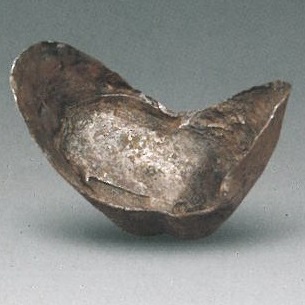 |
"Horse-hoof" ingot from the Wanyuanji Bank 萬源記, Jilin, weight 50 tael. Dai 2008:210. Click to enlarge (opens in new tab). |
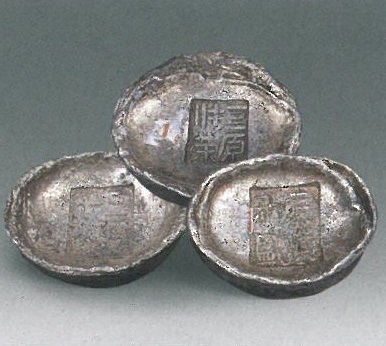 |
Silver cakes from the Sanyuan Bank 三原, Shanxi, weight 3 tael. Dai 2008:210. |
Silver was the second component of the bimetallic monetary system of the Qing dynasty. It was used as a unit of account, particularly in government ledgers (as the so-called
kuping tael,
kuping liang 庫平兩), but its production and measurements were not under the control of the authorities. Silver ingots were produced exclusively on the private market, and its exchange rate was determined by assayers and moneychangers. Only in the very late Qing period
silver coins were produced whose appearance was inspired by
foreign silver dollars. There was therefore no unified silver currency, but various types of silver ingots were used in various markets. Accordingly, the designations for the silver currency were manifold. The most famous English term was the word "sycee", derived from the Cantonese word
saisī 細絲 (lit. "fine weight", the weight unit
si representing 0.00001
liang). In southern Jiangsu and Zhejiang they were called
yuansi 元絲, in Jiangxi, Hubei and Hunan
yanche 鹽撤, in Shandong
xicao shuisi 西鏪水絲, in Sichuan
tucao 土鏪,
liucao 柳鏪 or
huixiang 茴香, in Shaanxi and Gansu
yuancao 元鏪, in Guangxi
beiliu 北流, in Yunnan
shicao 石鏪 or
chahua 茶花. Other designations were
qingsi 青絲,
baisi 白絲,
danqing 單傾,
shuangqing 雙傾,
fangcao 方鏪,
changcao 長鏪, etc. Apart from the great variety of names, the size of the
liang weight (see
weights and measures) differed from market to market. Among the largest liang was the
kuping tael ("tael" was the foreign name for the weight unit and unit of account
liang), used by the Ministry of Revenue as a real weight and a unit of account for tax collection. The Sea Customs tael (
haiguan liang 海關兩) was used as a unit of account for the trade tax introduced in 1858. The Canton tael (
Guangping liang 廣平兩) was widely used in Guangdong for trade with foreign merchants, and the Grain Tribute tael (
caoping liang 漕平兩) was used for measuring and accounting
tribute grain.
The most common shapes of silver ingots (
yuanbao 元寶) or ingot silver (
baoyin 寶銀) were the "horse-hoof" ingots (
mati yin 馬蹄銀), the heaviest of which had a weight of no less than 50
liang. The second important shape were the
zhongding 中錠 "middle-size ingots" with a weight of 10
liang. Much lighter were the
xiaoding 小錠 "small ingots", also called
xiǎokè (!) 小錁 or
kèzi 錁子, with a weight of between 1 and 5
liang. The fourth common shape were silver crumbs (
suiyin 碎銀 or
yinzi 銀子; in earlier ages,
yinzi was a name for the standard size of the silver ingot).
Depending on the purity of the ingots, they were traded at differing rates. The average ones (
wenyin 紋銀) were called
zubao 足寶, specimen of higher quality were called according to the surplus to be advanced on changing. For instance, an
er-si bao 二四寶 with a weight of 50
liang was valued as worth 52.4
liang. The (theoretical) purity of the standard
wenyin ingots was .935374. Other silver standards were geared to the
wenyin. The Shanghai tael used in the foreign concession, for instance, was called
jiuba guiyuan 九八規元 because it had 98 per cent of the purity of the Shanghai standard tael (
guiyuan 規元). The standard tael of Tianjin was called
xinghua 行化, that of Hankou
yangli 洋例.
The greatest amount of silver ingots was produced by private silversmiths (
yinlou 銀樓) in professional furnaces (
yinlu 銀爐). Only a very small amount was issued by government-owned banks in the late 19th century. All freshly cast ingots were sent to official assayers (
gongguju 公估局) where weight and fineness were marked with a brush. Yet such a determination was only valid on the local market, and not in other places, so a constant assessment of an ingot's value was the daily business of money changers. In daily business, the weighing of silver belonged to the normal procedures of each single transaction.
Source: Peng Xinwei 彭信威 (1954 [2007]), Zhongguo huobi shi 中國貨幣史 (Shanghai: Qunlian chubanshe), pp. 575-577.
The trade with Western merchants constantly grew during the 17th and 18th centuries. Because China did not purchase larger contingents of commodities from Europe, it was European merchants who brought foreign money to China. With the discovery of the American silver mines, this metal became the most important monetary metal around the globe, critically influencing the value also of silver in China. Apart from the trade, the high interest rates of China attracted many European merchants who lend money to Chinese merchants in Canton. A third reason was the arbitrage business with the different prices of precious metals, silver and gold, in different parts of the world. In China, for instance, gold was much cheaper than in Europe. Chinese merchants, on their side, used forged copper cash to buy foreign silver coins of full value. Silver also came to China by trade from
Japan.
The Chinese called foreign silver coins
yangqian 洋錢 "ocean money" or
fanqian 番錢 "barbarian money". In the mid-18th century the most important foreign silver coins circulating in the coastal provinces of China were the "horse money" (
maqian 馬錢) or "horse-and-sword [money]" (
majian 馬劍), i.e. the Dutch Ducaton, the
huabianqian 花邊錢 "decorated-rim money",
shuangzhu 雙柱 "double-pillar [dollar]" or
sigong 四工, i.e. the Spanish Carolus Dollar, and the "character-ten money" (
shiziqian 十字錢), i.e. the Portuguese Cruzado. Other designations for foreign coins were
daji 大髻 "large curls",
xiaoji 小髻 "small curls" (referring to the wig of the Spanish kings),
pengtou 蓬頭 (probably used for the US Dollar or US Trade Dollar on which a portrait of the Goddess of Liberty was shown, with "unbound hair"),
bianfu 蝙蝠 "bat" (perhaps a misinterpretation of the Mexican or US eagle).
The ealiest decription of Western silver coins is found in a chapter on "local produce" in Lüsong 呂宋 (i.e. Luzon, Philippines) in the book
Dong-Xiyang kao 東西洋考 from 1618. Chinese observers reported that this coin in fact came from Mexico, others said, from Spain. Mexico (Nueva España "New Spain") belonged to the Spanish empire, and the silver coins came to the Philippines by the so-called Manila galleons, and Chinese merchants brought the coins to the sea ports of Guangzhou, Xiamen or Ningbo.
Portuguese trade estblished with the occupation of Macao in 1557, twenty years later Spain had founded the Pacific route to the Philippines, in 1604 Dutch ships occupied the Penghu Islands, but lost them again in 1662. Great-Britain began the China trade in 1729, and at the end of the century the United States joined in the circle of nations trading in China.
Even if Chinese silver ingots (
yinliang 銀兩) and foreign silver coins (
yinyuan 銀元) were rated by the material value of their silver content, the Qing government was of the opinion that foreign silver coins were of lower value than silver ingots. Yet on the markets of the coastal provinces, particularly in Guangdong, the population highly esteemed the silver coins because they had a fix nominal value and a reliable fineness of silver, and could therefore be used for transactions without undergoing a process of assaying or weighing. In 1814 one single foreign silver coin was traded against no less than 723 copper cash in Guangzhou, and in the provinces of Zhejiang and Jiangsu even more than 800 (Yang: 258), or 0.73
liang of silver against one silver coin (Yang: 259). The exchange rate rose in the next decades and stood at between 1,500 and 1,900 copper cash against one silver coin.
The authorities therefore often proposed to ban the circulation of foreign silver coins in China, out of the fear that "good" Chinese silver went abroad, while "inferior" foreign coins inundated the markets of southern China. It can be found out that China indeed suffered a loss of 11 per cent when changing Chinese into foreign silver.
Some figures might demonstrate, which huge amounts of silver coins arrived in China between the 16th and 18th centuries. In the early years of trade in Macao, Portuguese merchans bought Chinese commodities for about 2 million silver tael annually, and in addition to what they shipped from Japan to China, which was about 41 million tael of silver until 1638, corresponding to about 1.65 million kilos of silver. The Spanish trade port in Manila was opened in 1567. Until the end of the Ming period, silver coins with a value of more than 40 million
kuping tael had been brought to China, with an annual amount of about 300,000 and a total volume of 53 million Pesos (Reales). The average Chinese junk, sailing from Manila to Canon, took about 80,000 Pesos with it. Until the mid-18th century the volume had increased to 235.370 million Pesos or 169.46 million
kuping tael. According to Spanish sources, the volume of silver coins shipped from Acapulco, Mexico, to Manila was 12 million Pesos in 1597, in other years between 1 and 4 million. It can be estimated that between 1725 and 1756 Dutch ships bought in Canon merchandise for 3.6 million tael of silver, between 1756 and 1794 82.697 tael. In direct trade, Japanese merchants brought annually an amount of 11,250 kilos of silver to China annually before 1600, with a total amount of probably 500 tons. After 1633, the Tokugawa Shoguns carried out a politics of seclusion (
sakoku 鎖国), and just 350 ships went to China until 1635. These ships nevertheless transported silver with a volume of no less than 1,000 tons per vessel.
In the very early 19th century Chinese administrators felt that more silver was going abroad than was coming in. The monetary balance fell into the negative side for the Chinese. Yet because the government did not compile statistics on the private silver market, it is difficult to rely on data. The earliest reference is provided by Hosea Ballou Morse (1855-1934), whose data show that the turning point was in 1826, when the balance fell from 1.3 million
yuan positive to 2.1 million negative.
The Spanish Dollar
The most important of the early foreign silver coins was the so-called Spanish dollar, a silver coin with the value of 8 Reales or Pesos. The Chinese called it "double-ball" coin (
shangqiu 雙球) because the obverse side showed two views of the globe, showing the result of the Treaty of Tordesillas concluded between Spain and Portugal in 1494, and thus the large empire controlled by the Hapsburg Spanish empire. The double-globe "dollars" dated from the time of Felipe V (r. 1700-1746) and Fernando VI (r. 1746-1759). The globes were flanked by two crowned pillars (the Pillars of Hercules), which were entwined with S-shaped banners (which is, by the way, the origin of the dollar sign $). The inscription around this scene said "VTRAQUE VNUM" ("both [hemispheres] are one [empire]") gave the date of production, and the signum M
o, meaning "M[exic]o", the place of origin. The reverse side was decorated with the coat-of-arms of the Spanish Empire, the inscription "[name of the king] HISPAN·ET·IND·REX", meaning "king of Spain and the Indias", the denomination (like 8, for eight Reales), and the initials of the assayers. From the reign of Carlos III (r. 1759-1888) on the pillars were shifted to the reverse side, flanking the coat-of-arms, and the picture of the global hemispheres replaced by a portrait of the king. In this shape, the coins became known as the Carolus Dollar, or old Mexican Dollar. On some coins the inscription "PLVS VLTRA" was found, meaning "[ever] further on". In Europe the coin was also called columnarius "with columns", in China as
zhuyan 柱洋 "pillar dollar",
shuangzhu, or
benyang 本洋 "main dollar" (probably in contrast to other foreign coins).
Examples:
http://coinquest.com/cgi-bin/cq/coins?main_coin=1197&main_ss_id=602930&main_ww_id=270
http://www.coinworld.com/news/us-coins/2014/04/classic-pillar-dollar-coveted-by-u-s--coin-collectors.html
http://cngcoins.com/Coin.aspx?CoinID=310580
http://www.columnarios.com/
The Old Mexican or Carolus Dollar
The standard weight of the Spanish Silver coins was 27.468g, with a purity of 0.93955, later on lowered to 0.902. On the reverse side of the old Mexican Dollar, from 1732 on produced in Mexico, but also in other places in Spanish America, the portrait of the reigning king of Spain was shown, beginning with Carlos III, and then continuing to Carlos IV [also written IIII] (r. 1788-1808) and Fernando VII (r. 1808-1833). Around the portrait was written "[name of the king] DEI·GRATIA" ("by the grace of God"), and the date of issue of the coin. All coins of Carlos III brought to China dated from 1790, those of Carlos IV from 1804. The production of Spanish silver coins in Mexico ended in 1825, and Mexico, having become an independent state in 1810, issued its own coins, the New Mexican Dollar. There were in total five denominations (0.5, 1, 2, 4, 8 Reales) of the "Pillar Dollar", the largest of which was 40mm wide and 2.5mm thick. The portrait of the Spanish king inspired the Chinese to dub the old Mexican Dollar
fotou yang 佛頭洋 "Buddha-head dollar". Not knowing Latin, Chinese people used to interpret the serif-style letters III and IIII (=IV) as multiples of the character 工, and so discerned the coins of Carlos III and Carlos IV as
sangong 三工 and
sigong 四工. In exchange business, the Carolus Dollar of 8 Reales was rated at a weight of 0.73
kuping tael. Since 1732 the old Mexican Dollar was machine-produced and had a riffled pattern at the rim. This is why the Chinese called this coin also
huabianqian 花邊錢 "money with decorated rim".
The Spanish Silver Dollar was such an important means of payment that the sums regulated in the Treaty of Nanjing from 1842 were accounted in the Carolus Dollar. The East Indian Company estimated that between 1681 and 1833 silver coins with a value of about 68 million tael arrived in China, which means more than 100 million coins, the greatest part of them being Carolus Dollars.
Examples:
http://coinquest.com/cgi-bin/cq/coins?main_coin=2334
http://cngcoins.com/Coin.aspx?CoinID=283005
http://www.chopmarks.com/info/forster-1.shtm
The New Mexican Dollar
When Mexico became an independent state, it coined the "eagle coin" (
yingyang 鷹洋, often erroneously or for the reason of simplicity written
yinyang 英洋, as if it was an "English Dollar"), the New Mexican Dollar, which became known in China since 1854. The Mexican Dollar is characterized by the coat-of-arms of the Republic on the reverse side, showing an eagle sitting on a cactus and devouring a snake, according to legend in a place where the Aztec capital was founded. The scene is accompanied by two twigs of olives and the inscription "Republica Mexicana". On the obverse side, the Jacobine Cap is shown, inscribed with the word Liberdad "Liberty", and sending out rays in all directions. Below this image, denomination, the date of issue, and the signs of the assayer are seen. The denominations were the same as that of the Spanish Silver Dollar. In the late 19th century, the currency Real was nominally replaced by the Peso.
Examples:
http://coinquest.com/cgi-bin/cq/coins?main_coin=533&main_ss_id=602950&main_ww_id=270
http://coinquest.com/cgi-bin/cq/coins?main_coin=4736&main_ss_id=602950&main_ww_id=270
http://cngcoins.com/Coin.aspx?CoinID=310580
The Dutch "Horse Dollar"
The Dutch silver Ducatons were known as
maqian 馬錢 "horse money" or
majian 馬劍 "horse-and-sword [money]", derived from the image of a galloping riding knight holding a sword. Ducatons were circulating in Fujian and Guangdong in the late 18th century. The smallest of these coins was weighing 0.867
kuping tael. With the conquest of the Netherlands by revolutionary France in 1795 the production of the silver rider dollar was ended.
Examples:
http://cngcoins.com/Coin.aspx?CoinID=216681
http://coinquest.com/cgi-bin/cq/coins?main_coin=20170&main_ss_id=602995&main_ww_id=270
The Japanese Dragon Dollar
The Dragon Dollar (
longyang 龍洋 or
longpan 龍番) finally was a Japanese coin circulating in the eastern provinces of China. It was introduced in 1870, and bore the inscription
Dai Nihon 大日本. The denomination was one Yen (
ichi en 一円), from 1874 on also inscribed with the word "One Yen". The Japanese Dragon Dollar served as the basic model for the native silver coins produced in late-19th century China.
Example:
http://chigasakiws.web.fc2.com/meiji-1yen-ginka.html
The Portuguese Cruzado
The Portuguese Cruzado was in Chinese called
shiziqian 十字錢 and circulated in southern China during the late decades of the 18th century. The appearance resembled the smallest of the Spanish Silver Dollars, and the largest Cruzado weighed just 0.56
kuping tael. The obverse side was decorated with a cross and the inscription IN HOC SIGNO VINCES "In this sign thou shalt conquer", and the reverse side with the arms of Portugal, the date of issue, and an inscription bearing the name of the ruling king. The denominations during that time were 50, 60, 100, 120, 240 and 480 Réis (plural of Real).
Examples:
http://www.coinfactswiki.com/wiki/Portugal_%281750-77%29_120_reis
http://www.terapeak.com/worth/portugal-silver-120-reis-6-vintens-d-joao-v-joannes-vkm-178-1706-1750-2/321826147230/
Others
Smaller amounts of the French silver écu were circulating in China, too. Just before the First Opium war, there were as much as a dozen different types of foreign dollar circulating in China, but the most widespread were the old Mexican Dollars, with which the East Indian Company and other companies paid their purchases of tea: It was forbidden to pay with British money. In 1866 a mint opened in Hong Kong, producing the Hong Kong Dollar (
Xianggang yinyuan 香港銀圓) with the portrait of Queen Victoria. It had a lower silver content than the Mexican Dollar and was therefore not accepted by the market, and demonetized seven years after its introduction. Another British coin was the British Dollar or British Trade Dollar with the inscription "One Dollar" (in English, Chinese, and Malay) and the portrait of the Goddess Britanny, introduced in 1895. It was by the Chinese called
zhanrenyang 站人洋 or
zhangyang 仗洋.
From 1868 on the new Japanese silver coin came to China, called „dragon dollar“ (longyang) because there was a dragon on one side of the coin. In 1873 the US created the American Trade Dollar (maoyi yinyuan 貿易銀元), specially designed for use in the China trade. Yet because its silver value was lower than that of the Mexican Dollar, it suffered the same feat as the Hong Kong Dollar and was abolished 14 years later.
Examples:
http://cngcoins.com/Coin.aspx?CoinID=294104 (Écu)
http://www.obsoletecoin.com/2013/07/british-trade-dollar-coins-price.html
http://www.numispedia.de/Trade-Dollar
http://www.usacoinbook.com/coins/dollars/trade/
Sources: Peng Xinwei 彭信威 (1954 [2007]), Zhongguo huobi shi 中國貨幣史 (Shanghai: Qunlian chubanshe), pp. 577-580.
While foreign silver dollars, used in the trade ports and later also in inland provinces of China from around 1700, were called
yangqian 洋錢, late silver coins produced in China from the late 19the century on were called
yinyuan 銀圓 or
yinyuan 銀元. First attempts to produce native silver coins were carried out in 1821. Commemorative silver coins with the portrait of the Panchen Lama nevertheless are known from the Qianlong reign-period. Machine-struck silver coins were first produced in 1822, by the modern Jilin Arsenal (
Jilin jiqi ju 吉林機器局). The money was called
changpingliang 廠平兩 "factory tael" and had the denomination of 1 tael/
liang. The coin is extremely rare as it was not produced in high numbers. Other models (
ban 板) of modern coins were known in Guangzhou, Fuzhou, Hangzhou, Suzhou, Wuxi (
xiban 錫板) and Jiangxi (
tuban 土板). There were also the models Wuzhuang 吳莊 and
xingzhuang 行莊. Another early attempt was carried out by Lin Zexu 林則徐, when he was
governor (
xunfu 巡撫) of Jiangsu. He had silver cakes (
yinbing 銀餅) produced with a weight of 0.72
liang, but they were rejected by the market. Lin also suggested in 1833 to create a
Daoguang tongbao coin with a weight of 0.5
liang, two of which would be exchangeable for one tael of silver. The earliest surviving modern coins of China was produced in Zhangtai 漳臺, Fujian. There were two types of it, one with an image (either the deity of longevity,
shouxing 壽星), two crossed
ruyi scepters 如意, or a pair of crossed writing brushes (
bibao 筆寶), the other type with ornaments and inscription. The first type was inscribed with the words
Daoguang nian zhu 道光年鑄 and
zuwen yinbing 足紋銀餅, and the indication of the value, namely
kuping qi-er 庫平柒弍 "0.72
kuping tael". On the rear side was a tripod with a Manchu inscription indicating the mint. This coin were brought into circulation as payment for troops (
junxiang), and were accepted by the local market. The coins without images were inscribed with the words
junxiang 軍餉, being a clear indication of the way the Chinese government used to throw money on the markets. The ornaments were mostly imitations of the decorations of various foreign coins, but sometimes just merged characters, like
jinshen 謹慎 "reverentially". The date when these modern coins of southeast China were produced is unclear, but certainly not before 1800. Another series of silver cakes was issued in 1856 by three banks in Shanghai, namely Wang Yong Sheng 王永盛, Jing Zheng Ji 經正記 and Yu Sen Sheng 郁森盛. Their cakes were made by steel matrices and had a weight of 1
liang and 0.5
liang. A year later the mint of Jiangsu also produced "cake" silver coins made with steel dies. In the decades that followed various regions produced silver cakes with differing dimensions and denominations, and only circulating locally and for short periods of time.
The first true mechanically produced coins were made by the mint in Jilin. The 5-
qian coins were inscribed with
Guangxu yuanbao 光緒元寶 on the obverse and
changping 廠平 on the reverse, as well as the name of the mint in Chinese characters and Manchu letters, left and right of the middle square hole. Apart from this coin in traditional Chinese style, the Jilin mint also produced Western-style coins, namely a one-tael standard (
chang ping yi liang 廠平壹兩) coin dated 1882, and made in silver and in copper, and a set of coins from 1884, inscribed in Chinese and Manchu, and with the denominations 1
liang, 7
qian, ½
liang, 3
qian, and 1.5
qian.
The governor-general of Liang-Guang, Zhang Zhidong 張之洞, in 1887 requested to the throne the allowance to produce a local silver coin with a weight of 0.73
liang, inscribed with the words
Guangxu yuanbao 光緒元寶 in Chinese, Manchurian and English (Kwang-tung Province, 7 Mace and 3 Candareens, written on the obverse side), and to be decorated with a dragon, as a symbol of the emperor. It was therefore known as the "Dragon Dollar" (
longyang 龍洋), which leads to some confusion with the Japanese silver dollar that was also decorated with a dragon, and with the New Mexican Dollar (
yingyang). Yet this new coin was 0.01
liang heavier than the Mexican Dollar because it was believed that the foreign coin would thus be driven out of the market. This earliest successful silver coin is known under the name of
qi-san fanban 七三番板 "0.73-tael coin according to the Western model". The expectations in respect to the Mexican Dollar did not fulfill, so the weight was soon lowered to 0.72
liang. The English inscription was also soon shifted to the reverse side. In this shape the coin became known as the Kwang-tung Dragon Dollar (
Guangdong longyang 廣東龍洋).
Nearly all provinces later imitated this modern coin. When Zhang was transferred to Wuchang 武昌, Hubei, in 1893, he also founded a modern mint in that city where the "Hu-peh Dollar" was produced. In 1897 the Beiyang Mint of Tianjin produced a modern Dollar for the province of Zhili (today's Hebei). Unlike the Dragon Dollars it was denominated one yuan. The design was changed several times in the next years. Nanjing produced the first modern silver coin in 1897. It carried the cyclical signs of the year of production, and the design was also changed several times. Anhui started production in the same year, Sichuan in 1898 (the famous "Szechuan Rupee"). Most diverse were the Dragon Dollars of Jilin. From 1899 Jilin added the cyclical name of the year of production. After 1901 all coins showed the image of the
taiji 太極圖, yet others were decorated with the image of a Rohdea plant (
wannianqing 萬年青) and bore, apart from Chinese and Manchurian, also an inscription in Turki with Arabian letters. Of this coins, smaller denominations were issued. While the "Dollar" had from 1908 on the denomination "11 [cash]" (1 cash would be 1 "dime"), there were also 2- and 1-cash coins. Yunnan issued modern silver coins as the latest province, namely in 1907.
Some provinces did not produce silver coins of larger denominations. Hunan issued only 1-cash and 2-cash coins, Taiwan 1 cash, 2 cash and 0.5 cash (XXX), Shanxi 2 cash, and Heilongjiang ½ yuan (5 cash). The Beijing mints just made some tests, but never issued own coins.
These modern-style silver coins, issued by each province independently, did not reach the same standard in weight, homogenity and fineness, and were therefore less accepted by the markets than the foreign silver coins were. Money exchangers even treated them like the traditional silver ingots and used to weigh them to assess their exchange value. In 1903 the central government had issued a decree to standardize the Chinese silver coins, but the decree was never implemented. The highest standard was probably achieved by the gold, silver and copper coins produced in Tianjin between 1906 and 1907. Only in 1910 it was decided to have a unified currency produced in Wuchang and in Nanjing. The coin was called
yuan 圓 or 元 (called "dollar") and had a standard weight of 0.72
liang. It was inscribed with the words
Da-Qing yinbi 大清銀幣 and was introduced into the market in October 1910.
The policital developments in late 1911 probably impeded the standardization of silver currency in China. The Beiyang Government 北洋政府 of the early Republican era produced coins with the portrait of President Yuan Shikai 袁世凱, while the National Democratic Government 國民政府 in Canton created such with the portrait of Sun Yat-sen 孫中山. Yet these new coins circulated along the old ones from the late years of the Qing empire, and silver ingots were still used as means of payment and store of value. The silver ingots were demonetized in 1933, and the old silver dollars two years later, when paper money was introduced.
Sources: Hong Jiaguan 洪葭管 (1992), "Yinyuan 銀元", in Zhongguo da baike quanshu 中國大百科全書, Zhongguo lishi 中國歷史 (Beijing/Shanghai: Zhongguo da baike quanshu chubanshe), Vol. 3, p. 1409. ● Peng Xinwei 彭信威 (1954 [2007]), Zhongguo huobi shi 中國貨幣史 (Shanghai: Qunlian chubanshe), pp. 581-596.
See also history of paper money in China.
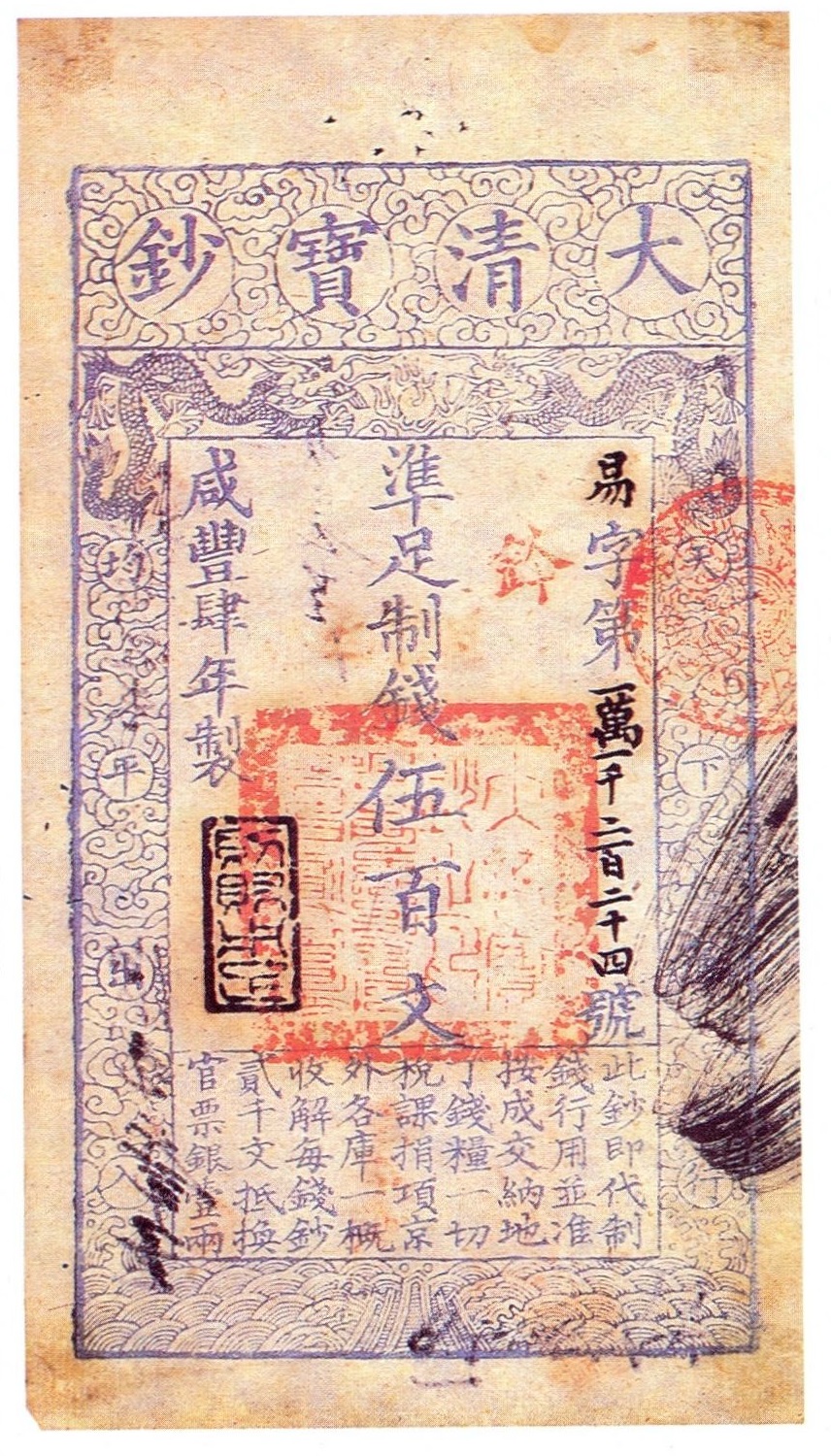 |
Da-Qing baochao 大清寶鈔 note, denomination 500 cash. Nei Menggu 1992: Pl. 16. Click to enlarge (opens in new tab). |
 |
Hubu guanpiao 戶部官票 note, denomination 10 tael. Nei Menggu 1992: Pl. 16. Click to enlarge (opens in new tab). |
During the war against the last princes of the Ming dynasty (the Southern Ming), the finances of the empire were in hard distress. Minister of Revenue, Wei Xiangshu 魏象樞, therefore suggested to introduce paper money to cover the immediate expenses. The first notes were issed in 1651 and declared invalid ten years later. An annual amount of 128,000
guan were produced, with a total sum of 1.28 million
guan. The denominations followed the pattern of the Ming period paper notes, but historiographical sources about early Qing paper money are scare, so not much can be known about them.
Only on rare occasions officials suggested to reintroduce paper money, like Cai Zhiding 蔡之定 in 1814, or Wang Yide 王懿德 in his treatise on money,
Qianbi chuyan 錢幣芻言. Yet a "private type" of paper money (
sipiao 私票) was used in the markets, namely various types of promissory notes issued by merchants of bankhouses, like
huipiao 會票,
yinpiao 銀票 "silver notes" or
qianpiao 錢票 "cash notes". Designations varied from place to place, and there were names as
pingtie 憑帖,
duitie 兌帖,
shangtie 上帖,
hupingtie 壺瓶帖 or
qitie 期帖. The denominations of such promissory notes were sometimes as high as 5
diao 吊 (i.e.
guan). The most important issuers were private banks (
qianzhuang 錢莊), but from the mid-19th century on Western credit institutes began running business in China, thus introducing modern credit instruments to the traditionial Chinese business world, like bills of exchange, promissory notes, or paper money (
fanpiao 番票).
The first kind of Qing paper money (
chaopiao 鈔票) were
Da-Qing baochao 大清寶鈔, inspired by the model of the
Da-Ming baochao 大明寶鈔 from the Ming period, but with smaller dimensions. The
baochao, denominated in copper cash (
zhiqian), were also called
qianpiao "cash notes", and issued with the denominations 250, 500, 1,000, 1,500 and 2,000
wen (or cash), later on, with the increasing inflation, also 5,000, 10,000, 50,000 and 100,000 cash. Another type of note, the
yinpiao "silver notes", was issued by the Ministry of Revenue (
hubu), and was therefore called
hubu guanpiao 戶部官票. It was denominated in silver tael, with the values 1, 3, 5, 10, and 50
liang. The notes were inscribed in Chinese characters and Manchu letters, and it was declared that they had to be discounted by two per cent when exchanged into Beijing market silver (when counted against
kuping tael, the notes were discounted at 6 per cent). The cash notes were imprinted with a note that they were convertible into copper cash, and could not be used for tax payment. The conversion rate between cash notes (
qianchao 錢鈔) and silver notes (
guanpiao) was 2 to 1. The term
chaopiao was first used only for paper notes issued by the government, but later on was also used for private paper notes issued by banks and merchant companies.
In the last few decades of the 19th century, private banks and merchant companies used two types of paper money, namely one denominated in Chinese money, and others in foreign currencies. Mackellar 麥加利, Huifeng 匯豐 (Hong Kong and Shanghai Bank of China), Dehua 德華 (Deutsch-Asiatische Bank) and Huaqi 花旗 (City Bank of New York) produced notes in tael (
yinliang 銀兩) and Chinese silver dollars (
yinyuan 銀元), the latter denominated in 1, 3, 10, 50, and 100
yuan, the former in 1, 5, 10, 50 and 100 tael/
liang. They were much used in the Yangtze River region. In Northeast China, the Russo-Chinese Bank (
Hua-E daosheng yinhang 華俄道勝銀行) issued Ruble notes (
lubu piao 盧布票), and Japanese Banks military notes (
junyong piao 軍用票). Later on the Yokohama Specie Bank (
Yokohama shōkin ginkō 横浜正金銀行) issued gold notes (
jinpiao 金票) and Hong Kong notes (
Xiangbi 香幣) circulating in Southern China. In 1895 the first notes denominated in
yuan 圓 were issued, concurrently by the State Railway Company of Beiyang 北洋鐵軌官路局. They were printed in London and must be seen as the first modern paper bills of China, designed in a horizontal mode, in much smaller format than the traditional notes, and inscribed in Chinese and English ("Imperial Chinese Railways"). In the same year the Central Paper Money Office in Tainan 臺南官銀錢票總局 issued notes denominated in 1, 5 and 10
dayuan 大圓, and following the traditional outlook of paper notes. The monetary units
yuan 元 and 圓 were first seen during the late 18th century.
The Imperial Bank of China (
Zhonghua diguo yinhang 中華帝國銀行, in 1912 renamed Commercial Bank of China,
Zhongguo shangye yinhang 中國商業銀行) was founded in 1897, following a suggestion of Cheng Xuanhuai 盛宣懷 (1844-1916), and a year later issued the first commercial cheques (
duihuanquan 兌換券) of China, denominated in tael or in
yuan. Provincial offices also issued local notes. In Hubei, the Money Office (
guanqianju 官錢局) produced a 1,000-
wen cash note, first in the old fashion, but under the guidance of governor-general Zhang Zhidong 張之洞, a modern-style note was introduced in 1899. It was produced in Japan with high-quality methods, but had still a vertical design. In Guangdong, a modern note was introduced in 1904, denominated in 1, 5 and 10
yuan. It was also printed by the Ministry of Treasury in Japan (
Nihon ōkura shō 日本大藏省), but had a Western-style vertical design.
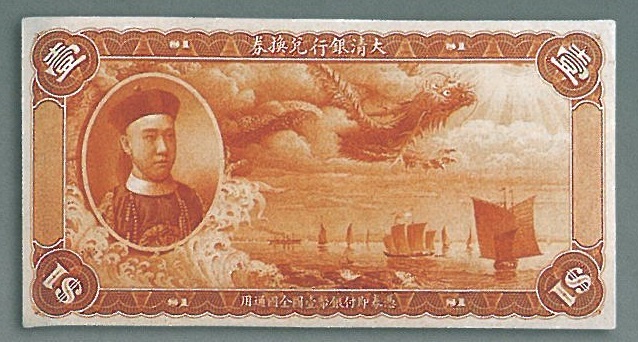 |
One-Dollar note of the Ta Ching Government Bank, with the portrait of Prince Zaifeng. Dai 2008: 317. Click to enlarge (opens in new tab). |
The discussion about a national bank was ended in 1905. Peng Shu 彭述 had claimed that before introducing new paper bills, the bank would have to keep sufficient reserves in "touchable" money (
xianjin 現金). The large number of private notes was to be restricted by introducing a stamp duty (
yinhua shui 印花稅). At the end of the year the Bank of the Ministry of Revenue (
Da-Qing hubu yinhang 大清戶部銀行) was founded, and the production of the notes entrusted to the prints of the Beiyang Newspaper (
beiyang baoju 北洋報局). A year later students were sent to Japan to learn about modern printing techniques, with the aim to have the Shanghai Commercial Press 上海商務印書館 printed cheques of the Ministry's Bank. There were still two types, one set denominated in tael (
yinliang piao 1, 5, 10, 50, 100), and one in
yuan (
yinyuan piao 1, 5, 10, 50, 100). In 1907 the Ministry of Revenue was renamed XXX
duzhibu, and the bank was renamed
Da-Qing yinhang 大清銀行. Accordingly, the inscription on all notes had to be changed. Following the tradition of issuing new money in a new reign-period, the Xuantong administration had the design of the official paper notes somewhat changed. The new design was inspired by the US Dollar, and the bills showed the portrait of
Li Hongzhang 李鴻章, others that of Prince Zaifeng 載灃, the current Minister of Finance. At the eve of the Xinhai Revolution in 1911, there were 5.4 million tael of
yinliang notes circulating, and 12.4 million
yuan of
yinyuan notes.
Yet old notes were still in use, from the traditional private bills (printed on just one side) issued by merchants banks (
qianzhuang,
yinhao 銀號,
shangpiao 商票) and
pawn shops (
diandang 典當) and the old-style notes issued by provincial institutions, to the modern notes introduced by a dozen or so of foreign banks and modern Chinese banks which sprung up in large numbers in the very late 19th century, notes brought into the financial markets by government-owned firms like railway companies, and foreign bills coming to China through the trade ports like Shanghai. The spectrum of these types of paper bills reflected the structure of the credit market in the late Qing period.
The traditional credit institutes were local
qianzhuang,
yinhao or
piaohao 票號 banks, and pawnshops, of which a considerably number was to be found in each city. Many provincial governments founded provincial, state-owned banks (
guanqianju 官錢局 or
guanyinhao 官銀號), in some provinces even several credit institutes were to be found, like the Yuning Bank 裕寧官銀錢局 and the Yusu Bank 裕蘇官銀錢局 in Jiangsu. Quite a few of them had even branches in other provinces. Foreign banks brought a new type of financing to China and inspired Chinese entrepreneurs to found similar institutions in China, some government-owned, others run privately. Such were the
Zhongguo tongshang yinhang 中國通商銀行 (Commercial Bank of China),
Da-Qing yinhang 大清銀行,
Jiaotong yinhang 交通銀行 (Bank of Communications),
Siming yinhang 四明銀行 (Ningpo Commercial Bank),
Zhibian yinhang 殖邊銀行 (Bank of Territorial Development),
Zhejiang xingye yinhang 浙江興業銀行 (Hsing Yeh Bank or Industrian Bank of Che Kiang),
Zhejiang yinhang 浙江銀行 (Che Kiang Bank), the
Zhongguo xincheng yinhang 華商上海信成銀行 (Sin Chun Bank of China) in Shanghai, the
Xinyi gongshang chuxu yinhang 信義工商儲蓄銀行 (Hsin I Savings Bank) in Hankou, the
Chuxu yinhang 北京儲蓄 and
Baoshan yinhang 寶善銀行 in Beijing, or the
Hetai yinhang 和太銀行 and
Huashang tongye yinhang 華商通業銀行 (Chinese Mercantile Bank) in Yangzhou. Even if the number of these banks was not very high, their business had a great impact on the modernization of the financial and monetary system during the late imperial and the early Republican era. Even government-owned institutions like the railway companies can be seen as credit institutes because they issued their own paper notes.
Seen from the denominations, there was likewise a wide range of types of paper bills. The traditional copper cash was reflected in cash notes (
qianpiao), some of which used the traditional exchange rate of 1,000 cash/
wen per string (
diao), while others used differing rates, like the Eastern cash (
dongqian 東錢) of Fengtian province, with 160 cash per string, or the metropolitan cash (
jingqian 京錢) with a rate of 500 cash per string. On the markets, the exchange rates even deviated from the denominations, as had been use with cash of substandard quality since long ago. The silver currency was reflected in silver notes (
yinpiao), and also in this type of paper money, there were great differences in the conversion rate. In Beijing, the
kuping tael rate was used side by side with the metropolitan rate (
jingping liang 京平兩), while the Huifeng Bank and the
Shanghai tongshang yinhang 上海通商銀行 were both denominated in the Shanghai tael (
Shanghai wenyin 上海紋銀). The denominations on the Yuan notes (
yinyuan piao 銀元票) were most standardized, but exchange rates differed on the individual markets, depending on the value of the Silver Yuan. A last attempt at clarifying this chaotic situation were the Statutes for Paper Bills (
Tongyong yinqian piao zhangcheng 通用銀錢票章程) issued in 1909.
 |
Tibetan silver coins from the Qianlong, Jiaqing, and Daoguang reign-periods. Dai 2008: 229. Click to enlarge (opens in new tab). |
In Tibet, silver coins became common from the mid-18th century on, when the Gorkha and Nepalese began dominating Central Tibet. With the trade, their coins came to Lhasa and were seen imitated. They had a weight of 0.15 kuping tael and were called tangka or thangka (in Chinese zhangga 章噶). Gorkha coins were much better than the Nepalese ones, and began a price battle against Nepalese coins. The Qing colonial minister resident (amban) in Lhasa finally decided to carry out a currency reform and to introduce an own silver curreny in Tibet. The currency included coins of three denominations, the largest weighing 0.15 liang (with a conversion rate of 6 coins to 1 silver tael), the middle one 0.1 liang (9 coins : 1 silver tael), and the smallest one 0.5 liang (18 coins : 1 silver tael). The coins were issued with a premium (shui-huo-gong qian 水火工錢) of ten per cent to cover the production cost, and were inscribed with the legend Qianlong baozang 乾隆寶藏 (this is the official reading, but it should actually be read Qianlong zangbao), in Chinese characters on the observe, and in Tibetan script on the reverse side. They were also the only traditional Chinese coins which carried the date of issue (Qianlong 58-60). In the middle, the conventional square hole of the Chinese coins was indicated, but not cut through. The heavy coin was not very widespread because the market preferred using the old Gorkha and Nepalese which had the same weight. The production numbers of the smallest tangka were low because of the relatively higher production cost. New tankas were produced during the Jiaqing and then during the Guangxu reign- period. There were of a likewise high quality, but thinner than the Qianlong coins. They also carried Manchu inscription on the back side, but not the date of issue.
Sources:
Dai Zhiqiang 戴志強, ed. (2008). Zhongguo qianbi shoucang jianshang quanji 中國錢幣收藏鑒賞全集 (Changchun: Jilin chuban jituan).
Gabrisch, Karl (1990). Geld aus Tibet: Sammlung Dr. Karl Gabrisch; Ausstellung des Münzkabinetts der Stadt Winterthur (Winterthur: Departement für Kulturelles; Rikon: Tibet-Institut).
Meng Peingxing 孟彭興 (1998). "Cong feiqian dao jiaozi huizi 從“飛錢”到“交子”、“會子”, in Zhang Dainian 張岱年, ed. Zhongguo wenshi baike 中國文史百科 (Hangzhou: Zhejiang renmin chubanshe), Vol. 1, 414.
Nei Menggu qianbi yanjiu hui 內蒙古錢幣研究會, Zhongguo qianbi bianjibu 《中國錢幣》編輯部, ed. (1992); Cai Mingxin 蔡明信 (transl.). Zhongguo guchao tuji (Beijing: Zhongguo jinrong chubanshe).
Peng Xinwei 彭信威 (1954 [2007]). Zhongguo huobi shi 中國貨幣史 (Shanghai: Qunlian chubanshe), 580-581, 597-605.
Xie Tianyu 謝天宇, ed. (2005). Zhongguo qianbi shoucang yu jianshang quanshu 中國錢幣收藏與鑒賞全書 (Tianjin: Tianjin guji chubanshe), Vol. 2, 508.
Zhou Fazeng 周發增, Chen Longtao 陳隆濤, Qi Jixiang 齊吉祥, ed. (1998). Zhongguo gudai zhengzhi zhidu shi cidian 中國古代政治制度史辭典 (Beijing: Shoudu shifan daxue chubanshe), 372, 375, 380, 381, 382.






